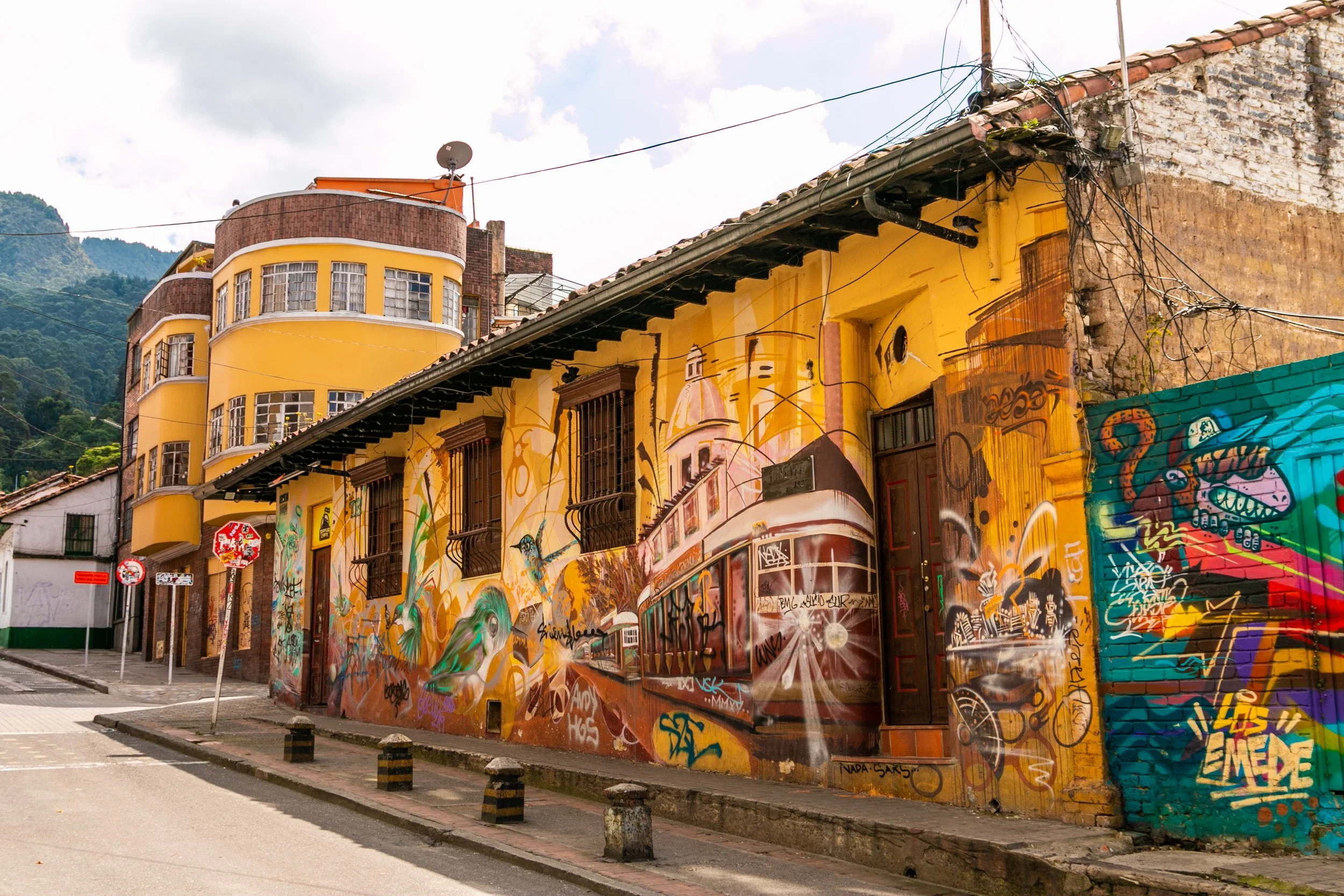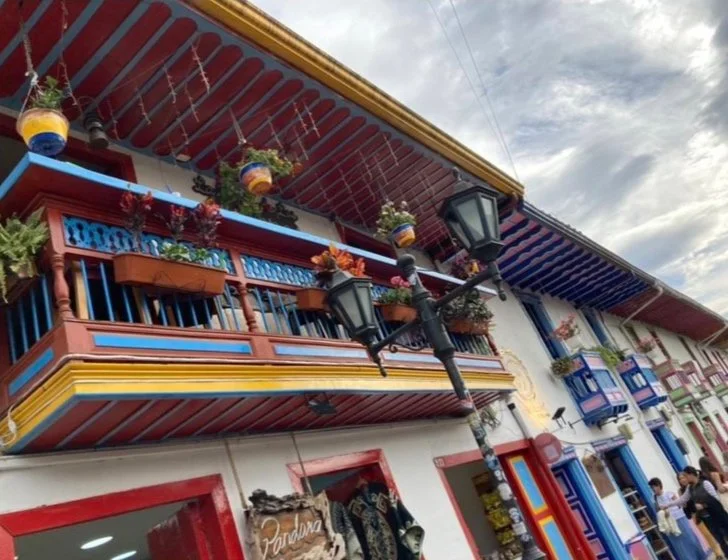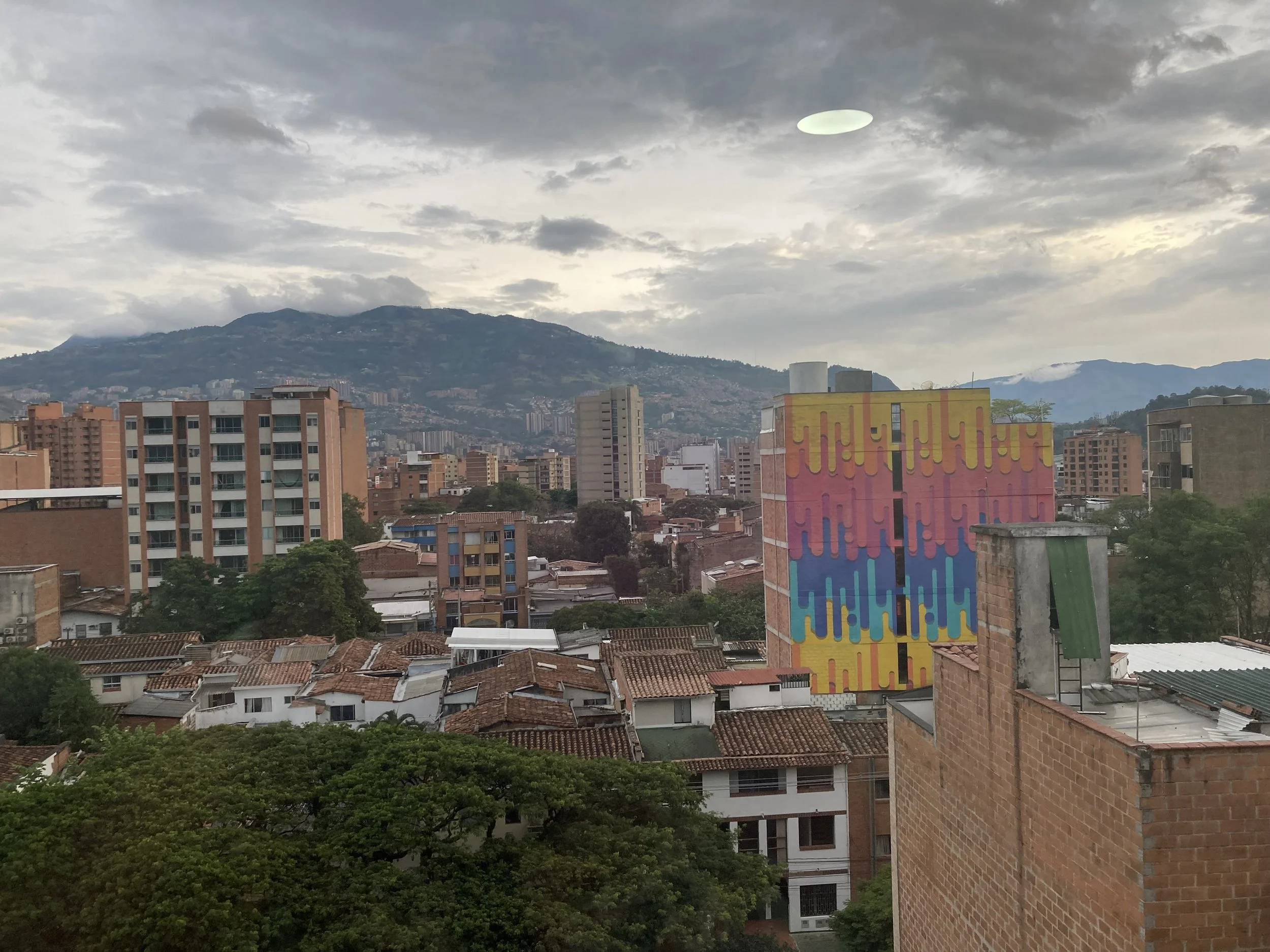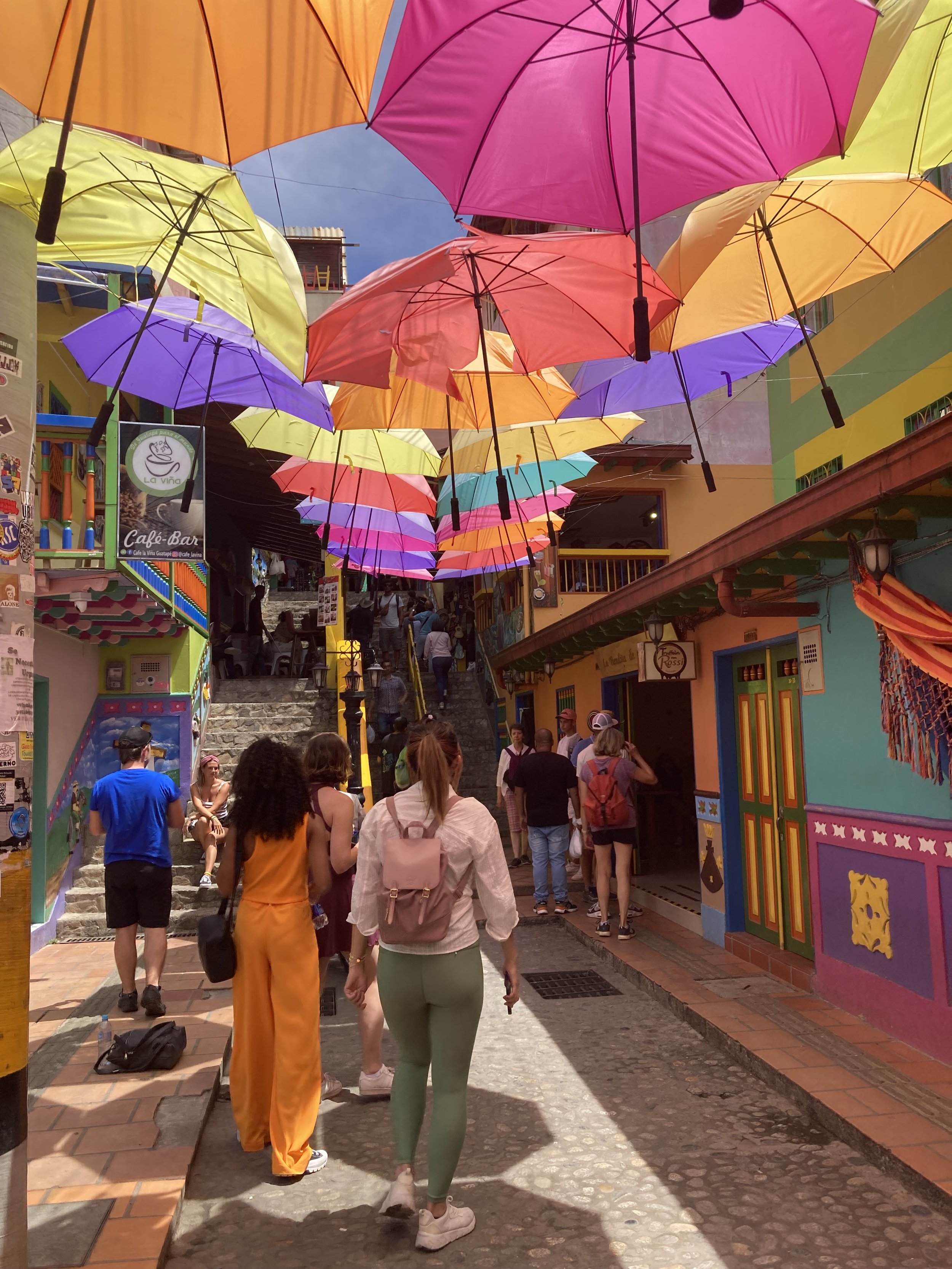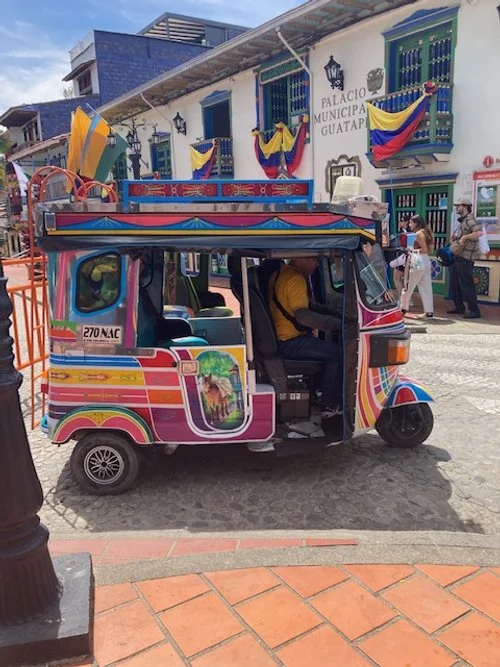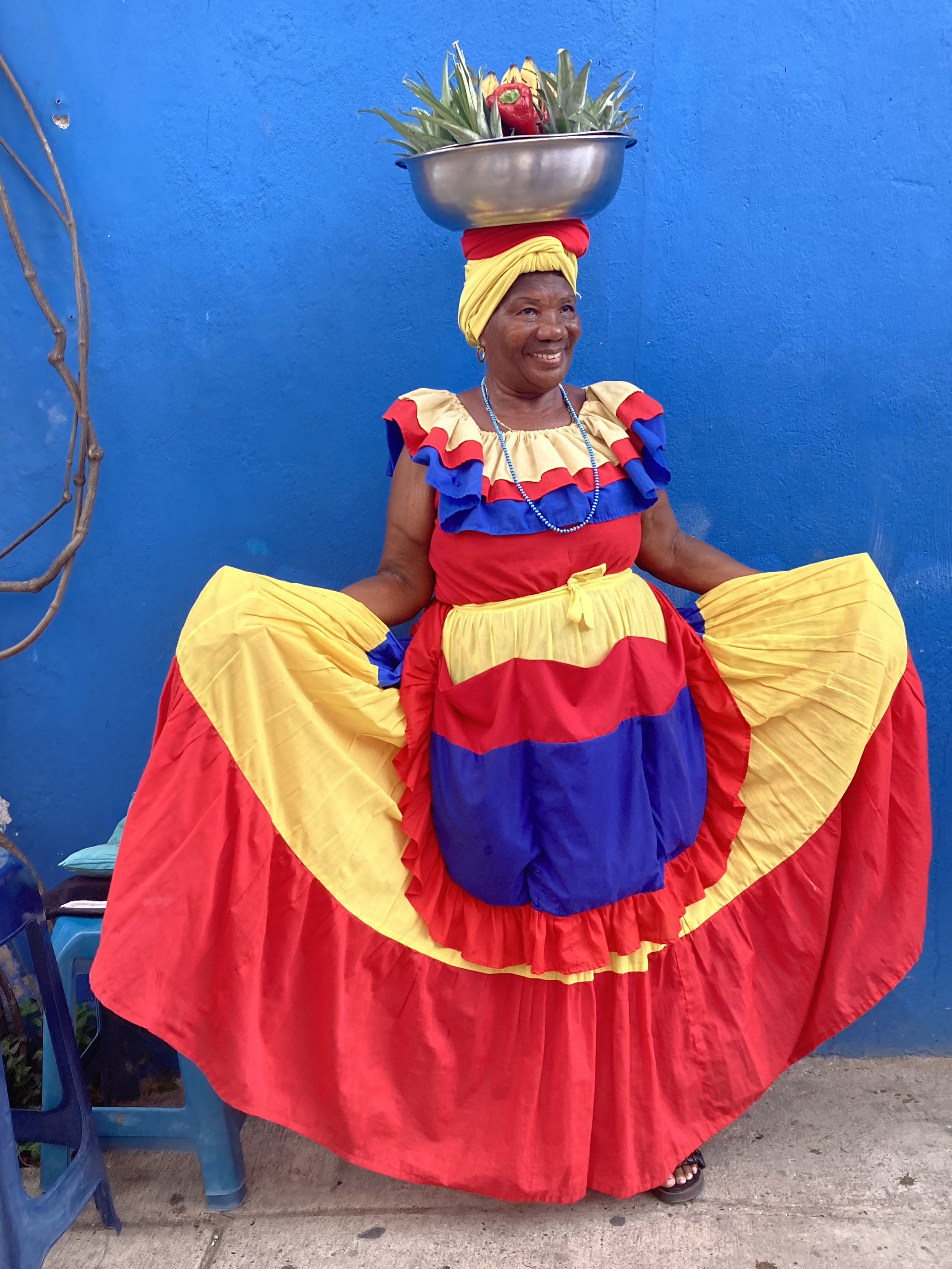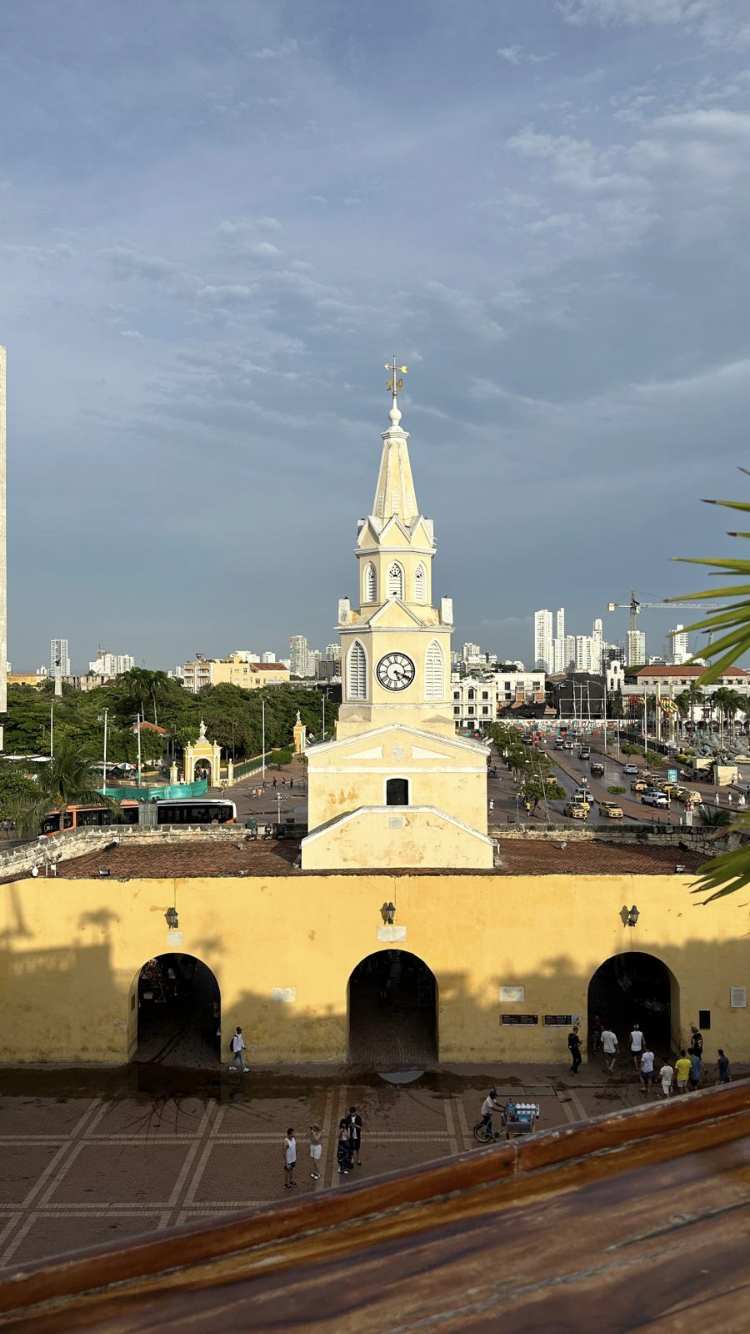From palm forests to quaint towns to the scenic Caribbean, Colombia defies stereotypes and should be a must-visit destination on your South American travels.
Quindio Province, Colombia. Amy Schrier.
I visited Colombia this past August, a country of amazing natural beauty and culture. Some still associate the nation with guerrilla armies, violence and cocaine. However, since 2016, the land has been at peace, and tourism is growing. I was amazed by the country’s diversity of landscapes. I explored Bogota, the coffee-growing region of Quindio, the town of Salento, the city of Medellin, the quaint town of Guatape and the Caribbean coast of Carthagena. The trip was organized exclusively for travel influencers and travel journalists by the small group tour company G Adventures, which offers hundreds of group tours around the world.
BOGOTA
The abundance of street art in Bogota. Paula Kindsvater. CC BY-SA 4.0
I landed in Bogota at night, it is a bustling urban center of seven million people. Out of my taxi window, I saw people on the dark roads and highways dressed in city maintenance worker outfits, who were painting impressive works of art on the walls of some buildings. I asked my taxi driver about this, and he explained that there is an abundance of street art in Bogota, and artists need only apply with a sketch of their envisioned work to receive the space to create it. This scene would play out very differently where I live in New York City, where workers clad in official uniforms spend their days removing analogous art that the city views as graffiti. An abundance of street art can be found in Bogota, and some hotspots include La Candelaria, Avenida El Dorado and Galeria Visaje. There are even dedicated graffiti tours that travelers can experience.
Areas to visit in Bogota include the Candelaria neighborhood, the city’s most historic and beautiful neighborhood. There you will find amazing architecture, a colonial-era cathedral and narrow streets filled with merchants selling emeralds and crafts. Many museums make their home in the city, the most famous being the Museo del Oro (Gold Museum). It has more than 55,000 pre-historic gold artifacts excavated from Colombia. Fernando Botero is a world-famous Colombian sculptor, whose work can be found in the eponymous Botero Museum.
COFFEE REGION
A coffee farm in Quindio province. Amy Schrier.
After exploring the lively streets of Bogota, I shifted gears by traveling to the famous coffee-producing department of Quindio by plane. The province is located in the western central region, where I stayed in a hacienda and did an open-air jeep ride over the countryside, viewing a landscape of palm trees, mountains and open fields. There are many roadside restaurants with fantastic views of the plains where you can stop for margaritas and tostones (crispy, fried green plantains). One of the best sites to visit is the Tunel de Amor, in English the Love Tunnel, where the bushes grow along the road and join at the top; it is said the shape was formed by trucks passing through them. You stop on the road and see bicyclists and mopeds pass through, while farmers work in the nearby fields. Many coffee farms are available to visit and tour. Colombia produces 1.7 billion pounds of coffee annually, and is the third largest coffee producer in the world. However, 90% of the high-quality coffee is exported, so locals drink a lower-quality coffee called “Tinto.”
VALLEY DE COCORA
Valle de Cocora. Amy Schrier.
One of the most spectacular things I did in the Quindio region was to hike the Valle de Cocora. The peak is 7,800 feet, or about a mile and a half. The hike itself isn’t too long, but is challenging due to the steep ascent and elevation. The palm trees, which are the tallest of their kind on Earth at over 200 feet high and over 100 years old, stood out as natural wonders. I felt like I was in a monochromatic Dr. Suess Lorax watching the truffula trees. Horses wander around the mountain and are friendly to people. The region is home to more than 6,000 species of plants, 300 species of orchids, 250 species of birds and 61 mammals, among them puma, ocelot and condor. 400 hundred years ago, the region’s Indigenous people, the Quindos and Patches tribes, made human sacrifices to the moon at the mountain peak, and there is still a cemetery on the other side of the mountain. They did not believe that death was the end of existence, and believed the dead moved on to a better life. Climate change is wreaking havoc on this region. Historically, it has never seen temperatures greater than 82 degrees Fahrenheit; last summer it was 97 degrees. The difficult season of El Nino has never lasted more than 7 months, and our guide told me they expect it to be 36 months this year. Many fear these changes will drive native species to extinction.
SALENTO
Salento. Amy Schrier.
The quaint town of Salento in the western central region of Quindio is filled with traditional, colorfully painted doors, windows and balconies, a colonial church and town square, restaurants, bars and cafes. Many Colombian and international tourists come to visit. The mood in Salento is jovial and upbeat. I could not help but think how dissonant it seems that such a place could have been run by murderous guerillas as recently as 2016. The political instability began in Colombia in the late 1940s in a period called La Violencia, in which there were tensions, assassinations and riots caused by a conflict between the Liberal and Conservative political parties, which originated primarily simply due to farmers protecting their land rights. What began as a fight for land-ownership rights and anti-imperialism led in the 1960s to the founding of the left-wing guerrilla groups FARC, ELN and M19. These groups terrorized the local population and government in pursuit of their goals. Right-wing paramilitary groups formed to fight the guerrillas, and chaos ensued for decades. A peace treaty was finally signed between the guerrillas and the government in 2016.
The Colombians I spoke with had vivid memories of that time and talked to me about what life was like. The guerrillas would stop the trains and look for members of the opposing political party, and eventually people stopped using trains altogether to avoid them. People used buses to get to one place or another, and the people I spoke with remember buses being stopped by the guerrillas, who shook down the drivers for bribes. If the driver did not pay, buses would get shot up and painted with graffiti; after several refusals random passengers would be selected and murdered. Colombians simply got used to violence, got used to people being killed in their midst, got used to curfews and hearing gunshots and assassinations in the streets. Many were afraid to leave their homes every day. Guerrillas would recruit young kids directly from their parents’ house and force them to join up.
Most Colombians were grateful when the peace treaty with the guerrillas came in 2016. The FARC became a political party, not a guerrilla group. People could go ahead and live their lives. Tourism began. International investments came and grew the economy. Colombia today is available to visit in many places, but a number of regions are still unsafe, including the area around Cali, Arauca, Cauca, Norte de Santander and the Colombian-Venezuelan border due to crime, kidnapping and terrorism. Gangs still control many areas, including in Medellin, where there are 90 gangs with over 2,600 members. That said, the city center is quite safe. The government no longer fights the gangs, which still extort the residents in exchange for “safety,” but they keep the communities they manage largely free of crime. When there is a problem in these regions, people call the gangs, not the police.
MEDELLIN
Medellin. Amy Schrier.
Medellin is the second largest city in Colombia and is famous for its proud and ambitious people. All the locals you speak to here say wonderful things about it. It exists between two mountain ranges of the Andes — the city center and the most affluent districts make their home in the valley between. As houses climb the mountains on either side, the neighborhoods become poorer and poorer due to their distance and tougher journey to the prosperous city center. The city center is a busy area with many notable landmarks and architecture. Botero Plaza was a center for homelessness and sex work until 2004, when the city renovated it. The famous Colombian sculptor Fernando Botero donated 23 sculptures (each worth approximately $2-3 million) to line the square, and today it is a lively place.
The way to explore the city is via its extensive metro, which is clean and organized. Interestingly, the cost to ride the metro is based on and discounted according to one’s socioeconomic “class.” The government designates everyone by income in a class ranging from the lowest class 1 to the most affluent class 6. People who are refugees or live without electricity and water are designated class 0. All city services, including electricity and water, are priced by one's class. The Colombians I spoke with claimed that Colombia is free of racism but is classist. People tend not to marry or socialize with people outside of their class, and there are people of every race in each class. Racially, Colombia is 58% mestizo (mixed European and Indigenous), 20% white, 14% mixed Black and Indigenous, 4% Black, 3% mixed Black and Indigenous and 1% Indigenous. One local Colombian I spoke with who was half Black and half mestizo compared his experience living in Colombia to three years he spent living in Boston in the US. He said that in Colombia, he never felt racially discriminated against, but was shocked by how racially segregated Boston was.
COMUNA 13
Street Art in Comuna 13, Medellin. Amy Schrier.
Comuna 13 was once one of the most dangerous neighborhoods in Medellin. It was run by violent gangs that extorted the people and businesses, and it was plagued by guerrillas and paramilitaries. It is quite high on the mountain, which made it one of Medellin’s most disadvantaged neighborhoods. In 2011, the government invested in a solar-powered escalator to make it easier to access and began encouraging street art and breakdancing. This brought a large number of tourists to see the art and experience the escalator. There were many tourists when I visited, and the art was terrific, as were the breakdancers and musical performers.
BARRIO DEL PABLO ESCOBAR
Mural in the Barrio Pablo Escobar, Medellin. Amy Schrier.
Colombia is perhaps most well-known for its narco-terrorism and the cocaine trade. The people I spoke to said that Colombians hate this reputation, and in Colombia itself drug use is actually quite low due to social stigma; 0.7% of Colombians use cocaine as compared to 2.8% of US residents. Pablo Escobar was the most powerful man in the cocaine trade from the founding of the Medellin Cartel in 1976 until 1993, when he was killed by Colombian police. In addition to being a drug kingpin, he was responsible for thousands of assassinations and many killings and bombings of uninvolved civilians to cause mass intimidation. He was known for his elaborate estate, where he kept a collection of wild animals, including hippos, some of which escaped and are still going strong. There are now approximately 200 hippos running wild in Colombia, giving it the highest population of hippos outside of Africa.
Escobar was a drug lord and a politician, rising to the level of elected congressman in 1982 of the Antioquia department, home to his native Medellin. To disguise his corruption, Excobar sought out the votes of the Medellin community and gave out millions of dollars in free food, housing and other amenities to the poor. As a result, many people still revere him as a hero and a “Robin Hood.” One of the neighborhoods is still called “Barrio de Pablo Escobar;'' there, one can visit a local barber shop with many photographs and relics of his life. But most Colombians hate Pablo Escobar so much that they refuse to say his name in public and even refuse to educate the young people about this period in Colombia’s history, hoping it will be forgotten. The government razed one of his former homes in 2019 and replaced it with Inflexion Memorial Park, which commemorates the 46,612 people he assassinated or killed in his bomb attacks.
GUATAPE
Guatape. Amy Schrier.
Tuk-tuk in Guatape. Amy Schrier.
Guatape is one of the country’s most picturesque small towns, often considered the most colorful town in Colombia. Alongside a lake, it boasts colorful homes with brightly painted doorways and balconies with their famous “zocalos,” fresco-like panels which decorate the bottom of buildings, often signifying what the building is about. The town has a colonial church, a town square and little streets that climb its hills. You will find many little tuk-tuk vehicles that passengers can use to explore the city for just a few dollars. Most famous is its cobblestone streets covered with umbrellas, which make beautiful light shadows on the pedestrian streets below. Near Guatape town is the renowned landmark inselberg La Piedra del Penol (Big Guatape Rock). It rises 7000 feet, and its 600 steps can be climbed to reach the top to find spectacular views.
CARTAGENA
A palenquera in Cartagena. Amy Schrier.
Cartagena. Amy Schrier.
Carthagena was the last spot I visited on my trip. The temperature change was dramatic, as it got incredibly hot and humid. At 85 degrees, it felt closer to 100. Carthagena is famous for its walled city with narrow streets and pastel-colored homes with descending bougainvillea.
Scattered around the neighborhood are “palenqueras,” Afro-Colombian women who sell elaborate fruits that they carry on their heads. They are so-named for the nearby town of San Basilio de Palenque, founded as the first freed-Black town in the Americas in 1603. At that time, boats loaded with enslaved Africans sailed the waters of the Magdalena River, and when one was shipwrecked the African people it was carrying escaped, settled in nearby mountains, fought battles and freed enslaved people from the city of Carthagena and passing boats.
Cartagena is a tourist destination as it is on the Caribbean Sea, and there are many nearby beaches and beach clubs. You will find many upscale restaurants, cafes and bars in the historic walled city. Prices were considerably higher here than in other places in Colombia I visited. This region is famous for its rum, and many rum drinks alongside the local fish ceviche are on offer.
Overall, Colombia is a country diverse in culture, architecture and history. More than 4 million travelers visit each year, and that number is growing. Colombians are welcoming and friendly people, their food is delicious, and the cost of visiting is relatively low. I learned so much on my G Adventures visit there, and am excited to share this experience with other travelers.
THIS IS A GROUP TRAVEL TRIP OFFERED BY G ADVENTURES
Amy Schrier
Amy is the Founder and Head of Content at CATALYST PLANET. She has a lifelong passion for travel and has explored more than 40 countries across 5 continents. As a prolific editor and dedicated entrepreneur, she has successfully launched three travel content brands. She aims to deliver information about international issues and destinations to activists and travelers worldwide.



